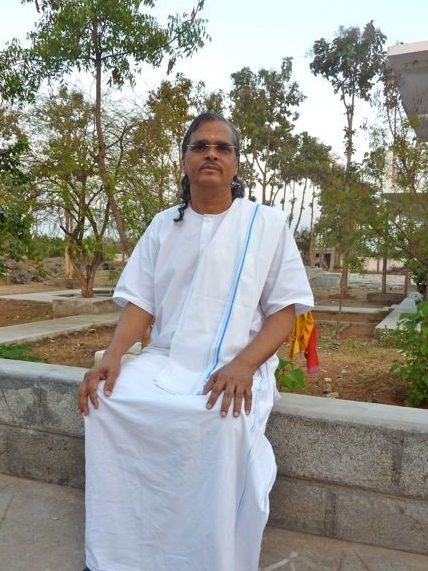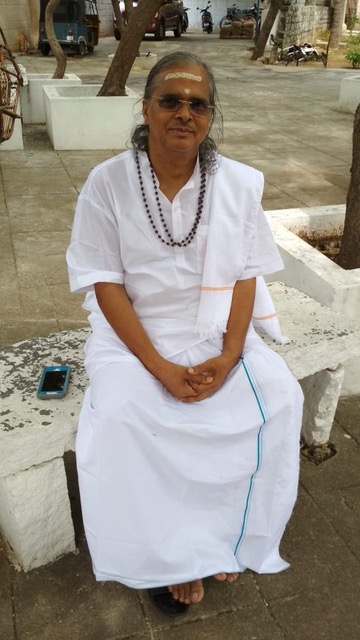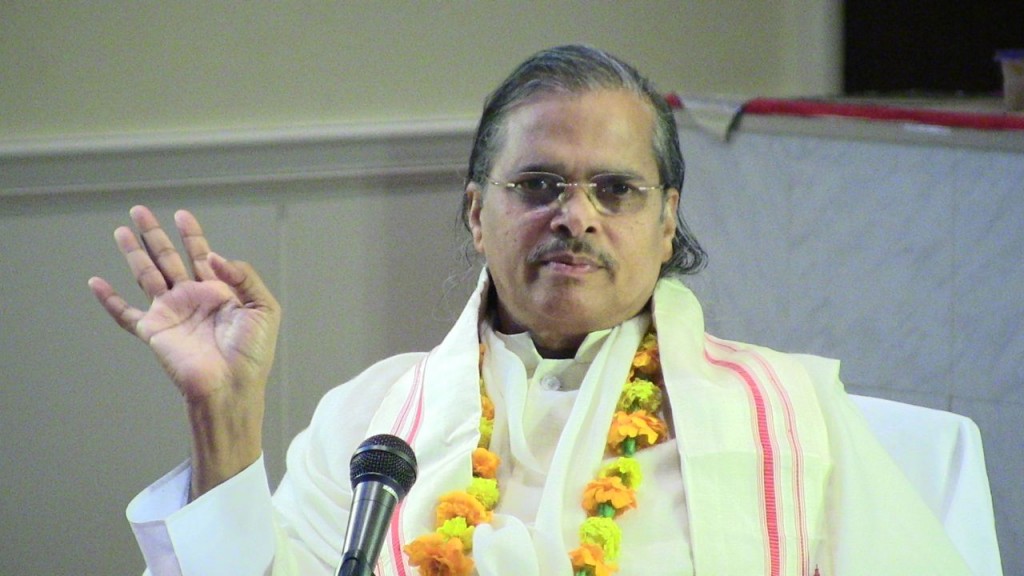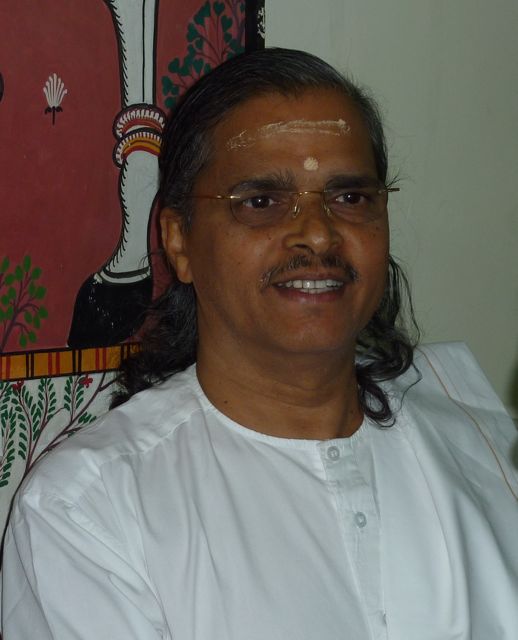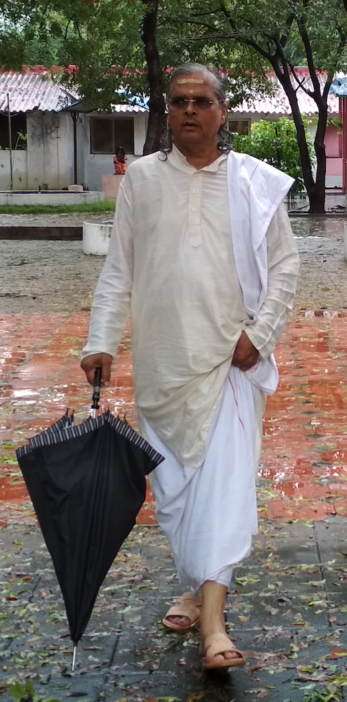
Omm Namo Bhagavate
Verse 474 says that the hardships for those whose minds are fixed on the unmanifest are greater, because the goal to realize the unmanifest is difficult for the embodied beings. What type of hardship is referred to here? Hardship may be faced for material expansion, and can also be experienced in spiritual emancipation—this is the hardship we are talking about.
Hardship is inevitable in life, whether in regard to expansion in the material plane or striving in the spiritual plane. But the hardship that is referred to here is a comparative statement. It is talking of hardship to expand spirit. The question is why the hardship for those who are in the manifest path is relatively less. What is referred to here as the unmanifest and what is the manifest? This is the key concept to be clarified first. As I have understood it, the words manifest and unmanifest refer to the path itself, and whether or not the path is visible to you or not. If the path is visible and you are able to walk towards your goal, that is the concept we are discussing. If the path is not visible but the awakening has come and aspiration is there, then the yogi desperately searches for a track.
We have seen many people psychically awakened, spiritually awakened. They are ethical beings, moral beings, ideal beings, they have true aspiration and a great deal of sense control, but even then they are not making progress in yoga. I have gone through this stage myself. Outer recognition had already come that I was a great yogi, but actually that was just self-deception. Outer recognition will come the moment you deviate just a little from the ordinary life. People will give you recognition that you are a yogi, a seeker, a devotee, but that is only “empty vessels sound much.”
Real progress can be felt within, and real progress will not come until the path is found. Before the path is found we simply put some new conditioning on our mind. Why? Because X or Y has said this, or in so and so book it is explained like that. This is the time when we talk more about yoga than about our experience as yogis, and we become philosophical. Yoga is not philosophy; yoga is direct experience, and direct experience will never come until one has found the path. If the path is manifest, the path is visible. If the path is unmanifest, it is not visible. A path can never be visible if a guide is not visible to you.
The symptom of a true yogi in the Gita path is discrimination between the striving in the zone of self versus the striving in the zone of non-self. Non-self is the zone of our mind and vital. Anything that we strive to achieve in our mind or vital zone is all striving for attainment in the world of non-self. Building a house is not a spiritual activity. But if a person is striving to build a house where he can stay for the sake of sadhana, or where seekers can come and stay for the sake of yoga, then the whole concept is different. That is striving for the sake of expansion of the awareness of the self.
Gita yoga is first the yoga of discrimination. Remaining in this action field we discriminate which action can expand our awareness and which can throw us again into the pool of experience. Any action that throws us to the pool of experience is not yoga.
A yogi in the Gita path to whom the path is visible, that means for whom the path is manifest, will always discriminate and will withdraw from those actions that are likely to cloud his awareness. Discrimination is an attribute, a visible symptom. A yogi to whom the path is visible, his actions are also visible. A yogi to whom the path is not visible, his actions are in the zone of mind and vital and senses.
How can we recognize a yogi who is really on the path of yoga? This is the question that was asked by Arjuna in the second step of the journey, in Verse 101: what are the signs and symptoms of one who has attained equanimity? Equanimity is a state in which your intellect is stabilized in the awareness of the being. Mind may not be stabilized, but intellect is stabilized. When the intellect is linked with the being, the person can always discriminate. There will be no impulsive or compulsive action, there will only be conscious action. This is the reason discrimination becomes a permanent companion to one to whom the path is visible. That is referred to here.
If the path is visible to you, there is no chance of you becoming derailed from yoga. But in day-to-day life, even great yogis perform hundreds of actions that do not take them towards the goal, that push them away from the goal or create a stumbling block for progress.
If the path is visible, the guide is visible. In Gita yoga, the guide is not only the guru, it is the scripture itself. Guru is simply a role model, someone to whom you can look for guidance, because that someone is himself an embodiment of the scripture that you are following.
This is the reason Krishna said to Arjuna, “Therefore let the scripture be your guide,” because you are in the field of action, but the guru by definition is someone who is beyond action, gunatita. All the actions that are necessary for you are unnecessary for one who has transcended the gunas. This is to be remembered.
Guru is one who is always established in the state of unity consciousness. He simply responds to your action; he does not throw you into action. He does not react to your errors and omissions in action unless you are really linked. If you are linked, the guru sometimes shows approval and sometimes disapproval. But if you are not linked at all, you may be living with him, but there will be no response. Guru in Gita is not one who is initiating action in you. Actions are being initiated in you through prakriti and the guru is a witness to this play and interplay of the gunas in your form.
When the path is visible, it means you have the scripture, you know its meaning, you have discrimination, are proceeding with confidence and there is a role model to whom you look when you are confused. Gita was revealed in the battlefield. Who was fighting the battle–Krishna or Arjuna? Arjuna was fighting, not Krishna. The guru does not fight any battle and does not do any sadhana because he has nowhere to reach. But just as Krishna was with Arjuna, the guide is with the seeker, the traveler. The seeker has to make progress and the guide will respond when the seeker needs it. Krishna will take the chariot only if Arjuna needs it. That’s why Arjuna said, “Take my chariot to the middle of the armies. Keep there until I have surveyed all those who have come to fight against me.” And Krishna did it.
If the seeker is not making forward progress, the guide has no compulsion of pushing him forward. This pushing forward occurs only if surrender has come. Then the guide has a role to push the seeker beyond.
I have thought over this for decades. Is a human guide necessary? My conclusion is absolutely, one hundred percent yes. Otherwise yoga becomes only philosophy and psychic romance. If you do not have someone to look toward, someone who is watching you and your action, and to whom you are answerable as far as your sadhana is concerned, no human being can really transcend the veil of maya.
Those who think that reading books, living in ashrams, and conducting seminars, conferences and study circles can give them enlightenment are simply chasing a mirage. They can never, never really transcend the veil. This is my experience, and the experience of all the enlightened beings.
The manifest concept here means, first the path must be visible. If the path is visible your scripture must have been found. If you have found your scripture, you must also have found your guide. If you have found your guide, then you have to ask yourself whether the guide is a living being or someone who lived once upon a time. If the guide is someone who lived once upon a time, then be sure you can never transcend maya. You can attain God-realization, but you can never transcend maya. It is not possible at all.
This is the reason Arjuna needs a Krishna, and the Krishna needs to be available to Arjuna. I have been with dozen of enlightened beings, but they were not available to me. I could not share anything–my turbulence, confusion, or revolt–and I could not release my anger to the master. So I could not make real progress. Real progress comes only when you have a form available, because you are still formal. You have not transcended the form. You still consider yourself to be a body and a mind. Until you have transcended that formal limitation, you need a form with whom you can act, to whom you can react and with whom you can interact. This is the most important concept that is explained in the twelfth chapter. In no other chapter has it been so vividly revealed.
A form is a must to transcend the veil, but a form is not a compulsive necessity to merge in the ocean of becoming. Many can reach the state of God-realization, but not all those who reach God-realization transcend the veil of prakriti. Manushyänäm sahasreshu kashchid yatatisiddhaye, out of a thousand who strive and attain, one knows me in reality. That message was very clear and profound. Those who follow the path of the unmanifest face greater hardship because they carry the possibility of going round and round and round, and the life comes to an end before the veil is transcended. They commit the same mistake again and again, not only in the material plane but also in the spiritual life because they do not have a formal guide who can shout and scream at them, warn them, punish them and impose on them. That is the implied meaning here.
Their hardship is also greater because they are still with the body. They consider the body to be real, but when the veil is transcended the body will never appear to be real. We all talk about the body as perishable: the doctor who treats you will advise you to take care of your body, and the enlightened master who has transcended the body also advises you to take care of your body, but the advice of the two persons is for different reasons. The doctor knows that with a sick body you cannot enjoy life, but the enlightened master knows that without the body the soul cannot reach its goal. An enlightened sadguru always emphasizes taking care of your body, not to enjoy life, but to transcend and transform life, and to manifest life as a channel of Divine. If you cannot take care of your health you cannot do yoga.
One can never transcend the body until one has transcended prakriti, because body is a product of the five components of prakriti: earth, water, fire, air and ether. Body is a product of these five elements and these five elements are components of prakriti. Only when you transcend prakriti will you not be identified with the body. Transcendence will never come without merger; merger will never come without realization; realization will never come without sense control; sense control will never come without determination; and determination will never come without aspiration. This is the reason aspiration is the key.
Sri Aurobindo has made the whole concept so simple. Aspiration is the key, because only aspiration can give you determination. Determination can give you strength for discrimination. Discrimination will enable you to be perfectly in the field of action, and only through action jnana, or knowledge, will come. Jnana will burn your karma and you will attain sannyasa (renunciation), sannyasa will lead you to samadhi, and in samadhi you will attain the state of the being. From the being to the becoming, the journey will be smooth and you become a part of the becoming. You, the bubble, wither away in the ocean itself. That’s the merger.
After withering away in the ocean as bubble, you, the bubble, again come out as a wave. You are part of the ocean but you are also not the ocean. That’s the state of the awareness of every enlightened being. As wave you manifest not you, but the beauty and the vastness of the ocean. A time comes when you reach this awareness: game is over, job is done, now let me withdraw, let me go back to the state of the absolute, the Brahman, from which I came. That’s the eighteenth chapter.
This is how the journey goes on in each individual form, and the manifest universe continues, because there are millions of sparks in millions of forms. That is why it is called the eternal, imperishable. What is perishable is the form through which the spark proceeds towards the goal. The spark is imperishable and the play is also imperishable, the eternal play. This is the eternal tree of Chapter Fifteen.
What is necessary is aspiration, and aspiration will never come until sattwa is sustained in your system. This is where I am taking Sri Aurobindo’s yoga deeper to its root. Integral Yoga begins with aspiration: “aspiration that calls from below and the grace that answers from above.” But where does aspiration come from? Can a tamasic person have aspiration? Can a rajasic person? No. Aspiration will come only if sattwa is maintained, sustained, nourished, and protected.
We are coming back to square one, back to the origin of traditional yoga that speaks of abhyasa (practice), jama, niyama (restraint), asana (posture) and pranayama (breath control). We are back to the point of origin, whereby nothing will happen in yoga without conscious sense control and mind control. That is the first step of the ashtanga yoga, the eightfold yoga. Jama is mind control and sense control. You have to practice these. You may be tamasic or rajasic in nature, but you have to impose these on yourself in the beginning to accumulate sattwa. When sattwa accumulates, aspiration rises. Then the journey is possible.
Masters come and go, but the sanatana path, this eternal path remains always. New masters use new terminology to explain the same concept in a different way so that people of that era can understand it, but to say that it was not there and X or Y explained it for the first time is the height of foolishness. Nothing new can ever be told; nothing new can ever be shown. We explain the same concept from a different angle.
When Buddhism became widespread what was the slogan? “Desire is the root of all evil. If you want to get rid of sorrow you must stop desiring.” The whole generation went mad with it, but nobody asked this question to Buddha, “We understand that sorrow comes from desire, but wherefrom does desire itself come?” Nobody asked that because the whole society was so tormented with desire that they all went mad with this concept. This is the reason another revival came. Sankaracharyaji came and asked this very fundamental question, “Wherefrom desire comes? Wherefrom sorrow comes, okay, Buddha has explained, but tell wherefrom desire comes.” Again back to Veda. This is how the play goes on and on and on.
I have given you the scripture that is not a compilation of the advice of a saint or seer or master. This scripture was revealed, not written. He who revealed it said, “It is revealed through me.” He has never said, “I am revealing it.” “Revealed through me. It was there, it will be there; only due to the impact of time it gets lost and it is revealed again and again. For that purpose I come, you come, we all come, because we are called and chosen.”
That’s the path we have found, the path that we are striving to make visible to those who want to walk through it. That is our mission. Our mission is not to create ashrams and centers or to create enlightened beings and seers. Our mission is, we should live life as explained in Gita. We should be living embodiments of Gita, so that through us this light will be transmitted to the masses. I am not talking of making X or Y or Z a guru or an enlightened being or a super-guide. Our mission is to make this path visible to mankind. For that purpose we have come. We can accomplish our mission only if we become the living embodiments of this pure wisdom. That’s our goal.
Neither enlightenment nor Self-realization and never God-realization are our aim, because we are the Being right from birth. We are Divine much before we know it. We are here not to gain anything, because everything here is already ours. This creation is ours. And we should not be worried to preserve something, because we are beyond gain and loss. There is no gain for us, and because there is no gain there is also no loss for us. If we can simply maintain this awareness, and we are determined to live the life and respond to prakriti the way prakriti wants to be responded, through our action knowledge will be manifested, through our reaction love will be manifested, and through our response truth will be manifested. That’s the mission of which I am talking.
That is what is visible to me, and some people are also able to see this, even if for them it is coming and going. This is the reason I say the hardship for those who are able to see the path is much less. You have found the scripture that can constantly speak to you. You have found a guide at whom you can look and compare your own state. And finally, you have a group; you are not alone. Arjuna was not alone in the battlefield. He had millions of people with him. Their number may have been fewer in comparison to the army of the Kauravas, but Arjuna was not alone. He had many commanders at his side, and many soldiers to fight and die for him. So also you all are a group. You are not a lone soldier; you are one among many soldiers and you should keep fighting, keep going, never to lose hope, never to feel left out, and never to run away from this battle to manifest the mission.
[From an April 2013 Interaction at Satyachetana Ashram, Tiruvannamalai, India.]

